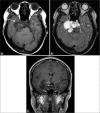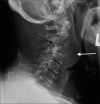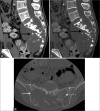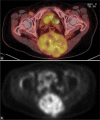Chordoma at the skull base, spine, and sacrum: A pictorial essay
- PMID: 36128361
- PMCID: PMC9479632
- DOI: 10.25259/JCIS_62_2022
Chordoma at the skull base, spine, and sacrum: A pictorial essay
Abstract
Chordomas are rare tumors believed to be arising from the notochord remnant in the axial skeleton. Diagnosis is often difficult since they show overlapping imaging features with other more common disease including metastases. Since individualized papers are only discussing the imaging features at different locations, the aim of this pictorial review is to have a comprehensive review on the common imaging findings of chordomas along the entire neuroaxis with a series of pathological proven cases in a local tertiary hospital in Hong Kong.
Keywords: Chordoma; Sacral tumor; Skull base tumor; Vertebral body tumor.
© 2022 Published by Scientific Scholar on behalf of Journal of Clinical Imaging Science.
Conflict of interest statement
There are no conflicts of interest.
Figures















References
LinkOut - more resources
Full Text Sources
